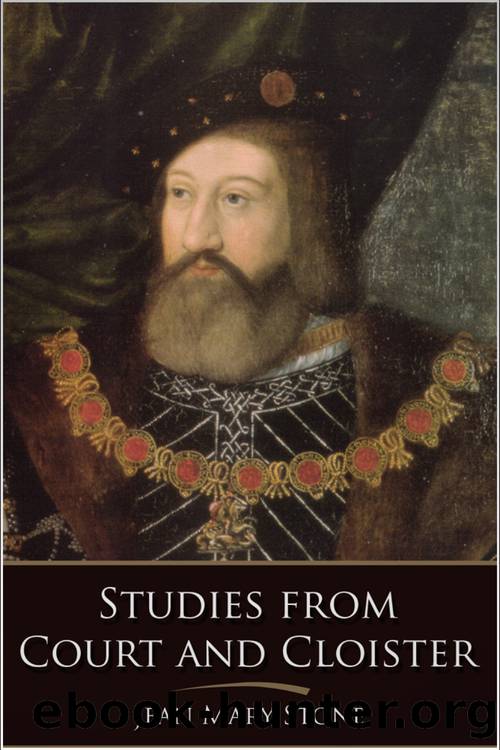Studies from Court and Cloister by Stone Jean Mary;

Author:Stone, Jean Mary;
Language: eng
Format: epub
Tags: history, england, english, henry viii, the middle ages, london, bible, religion
ISBN: 4460720
Publisher: Andrews UK Ltd.
Published: 2012-06-19T00:00:00+00:00
PART II
I. THE RUNIC CROSSES OF NORTHUMBRIA
There is at the Victoria and Albert Museum at South Kensington a remarkable plaster cast, the facsimile of one of the two beautiful obelisks of Anglo-Saxon workmanship, which like far-reaching voices speak to us across the gulf of at least nine centuries.
The interest which surrounds these ancient crosses is of a twofold nature. There is the marvellous art expressed in the sculptured stones themselves, and there is the mysterious charm of the runes with which the stones are inscribed. The art is of a very high order, and in the opinion of archaeologists such as Haigh, Kemble, Professor Stephens, and others, better than anything of the kind produced in mediaeval times, before the beginning of the thirteenth century.
The kingdom of Northumbria extended at its most flourishing period as far north as Edinburgh, so named after the great Northumbrian King, Edwin, its southern limit being, as its name implied, the river Humber. Thus, the Ruthwell Cross in Dumfriesshire, and the Bewcastle Cross in Cumberland, belonged alike to Anglia; for although Dumfries formed part of the kingdom of Strathclyde, the territory to the east of Nithsdale was generally reckoned a part of Northumbria, and if we were less hampered by our modern geographical limits and boundaries, we should better realise that the land north and south of the Tweed was one and the same country, without distinction of race or language. And as if in solemn protest of the political barriers, which were set up in the course of ages, these two obelisks, the one now in Scotland, the other in England, continue to point heavenwards, each bearing upon their faces the same grand old Northumbrian language, which is the mother-tongue of all English speaking people.
Both crosses have been, down to the present day, the subject of much diversity of opinion among antiquaries, first with regard to their respective ages, and secondly as to the authorship of the inscriptions on the Ruthwell Cross. The celebrated Danish antiquary, Dr. Muller, considered that the Ruthwell Cross could not be older than the year 1000, and he arrived at this conclusion by a study of the ornamentation, which he placed as late as the Carlovingian period, the style having been imported from France into England. Muller, however, though a good archaeologist, was not a runic scholar, and Professor George Stephens maintained* that not ornamentation merely, but a variety of other things must also be taken into consideration, and that these are often absolute and final, so that sometimes the object itself must date the ornamentation. Then Dr. Haigh, who had passed his life in the study of the oldest sculptured and inscribed stones of Great Britain and Ireland, stepped in and pronounced "this monument (the Ruthwell Cross) and that of Bewcastle to be of the same age and the work of the same hand; and the latter must have been erected A.D. 664-5."*
* Old Northern Runic Monuments, Afterwrit, p. 431,
He was led to this conclusion not by the ornamentation,
Download
This site does not store any files on its server. We only index and link to content provided by other sites. Please contact the content providers to delete copyright contents if any and email us, we'll remove relevant links or contents immediately.
